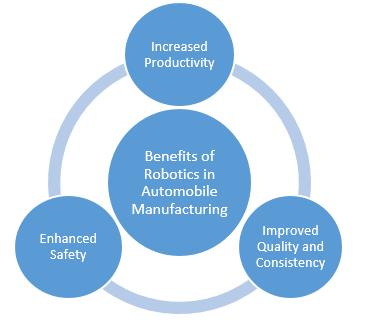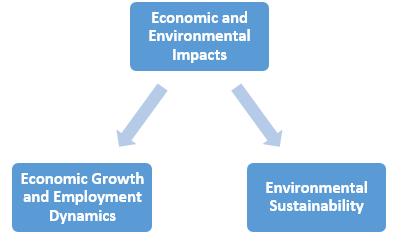
International Research Journal of Engineering and Technology (IRJET) e-ISSN: 2395-0056
Volume: 12 Issue: 01 | Jan 2025 www.irjet.net p-ISSN: 2395-0072


International Research Journal of Engineering and Technology (IRJET) e-ISSN: 2395-0056
Volume: 12 Issue: 01 | Jan 2025 www.irjet.net p-ISSN: 2395-0072
Kunal Kale1 , Sunil Katti2 , Manojkumar Khatal3
1Kunal Kale –DesignEngineer, Tata Technologies, Pune. kk929327.ttl@tatamotors.com
2Sunil Katti – Tech Lead, Tata Technologies, Pune. sunilkat.ttl@tatamotors.com
3Manojkumar Khatal - Manager, Tata Technologies, Pune. manojkum.ttl@tatamotors.com
Abstract - Theautomotiveindustryhasbeenattheforefront ofadoptingroboticstorevolutionizemanufacturingprocesses. This paper explores the extensive applications and transformativeimpactofadvancedroboticswithinautomobile manufacturing.Keyapplicationsincludeautomatedassembly lines, robotic welding, Autonomous Guided Vehicles (AGVs), andcollaborativerobots(co-bots).Eachofthesetechnologies contributes to enhanced production efficiency, improved product quality, and increased workplace safety. The integration of robotics leads to substantial benefits such as higher productivity, reduced idle time, and improved consistency, while also fostering economic growth and environmental sustainability. However, challenges such as high initial investment costs, integration complexities, and workforce transitions must be addressed. Technological advancements in artificial intelligence (AI), human-robot collaboration,andtheintegrationof5GandIndustrialIoTare shaping the future of automotive manufacturing. Despite the hurdles, the ongoing evolution and strategic adoption of robotics promise to maintain the industry’s competitive edge and drive continued innovation
Key Words: Advanced Robotics, Artificial Intelligence (AI), Automated Assembly Lines, Automotive Industry, Autonomous Guided Vehicles (AGVs), Collaborative Robots (Co-bots), Economic Growth, Environmental Sustainability, Human-Robot Collaboration, Impact on Productivity, Industrial IoT, Manufacturing Processes, ProductQuality,ProductionEfficiency,Robotics,Robotic Welding, Workplace Safety
The automotive manufacturing industry stands at the forefront of technological advancement, driven by a relentless pursuit of efficiency, precision, and innovation. Roboticshaveemergedasatransformativeforcewithinthis sector,fundamentallyreshapinghowvehiclesaredesigned, assembled, and produced. With their capacity to enhance productivity, improve quality, and ensure safety, robotic systems are now integral to modern automotive manufacturingprocesses
Despitetheclearbenefits,theintegrationofroboticsinto automotive manufacturing is not without challenges. High initialinvestmentcosts,complexintegrationprocesses,and theneedforworkforcereskillingpresentsignificanthurdles. However,thesechallengesaremetwithagrowingbodyof
technologicalinnovationsandstrategicapproachesaimedat maximizingthepotentialofrobotics.
As we explore the diverse applications and impacts of robotics in automobile manufacturing, it becomes evident that this technology is not only reshaping production practices but also setting new benchmarks for industry performance.Thisintroductionprovidesaglimpseintothe pivotal role of robotics in driving the automotive sector forward, highlighting both the advancements and the challengesthatdefineitsjourney.

Automatedassemblylinesarefundamentaltocontemporary automotivemanufacturing.Inthesesystems,roboticarms, integrated with advanced sensors and machine vision technology, perform complex tasks such as positioning components,securingbolts,andconductingqualitychecks. These robots work with remarkable speed and accuracy, guaranteeing consistent product quality and greatly shorteningproductiontimes.
Robotic welding systems have transformed the welding process in vehicle assembly. Utilizing sophisticated algorithms and real-time feedback, these robots execute intricate welds with high precision and consistency. By

International Research Journal of Engineering and Technology (IRJET) e-ISSN: 2395-0056
Volume: 12 Issue: 01 | Jan 2025 www.irjet.net p-ISSN: 2395-0072
removing the inconsistencies associate with human operators,roboticweldingimprovesstructuralintegrityand booststheoveralldurabilityofvehicles
Inautomotivemanufacturingfacilities,AutonomousGuided Vehicles(AGVs)areessentialforefficientmaterialhandling andlogistics.Theseself-drivingvehiclesfollowprogrammed routes to transport parts and materials between different production areas, streamlining the movement of goods throughoutthefacility.
By automating the transportation of components and materials, AGVs reduce the reliance on manual labour, allowingforsmootherandmoreconsistentoperations.This automation not only enhances workflow management ensuring that items reach their destinations promptly and accurately but also contributes to increased production efficiency.Additionally,AGVshelploweroperationalcostsby minimizingtheneedforhumanoperatorsanddecreasingthe likelihoodoferrorsordelayscommonintraditionalmaterial handlingsystems.
Collaborative robots, or co-bots, represent a significant evolution in human-robot collaboration within manufacturing environments. Unlike traditional industrial robots,whicharetypicallyenclosedinsafetycagestoprotect humanworkersfromtheirpotentiallyhazardousmovements, co-bots are designed to work directly alongside people withoutsuchbarriers.
Theserobotsareequippedwithadvancedsensorsandsafety features that enable them to detect and respond to the presence of human workers, ensuring a safe working environment.Co-botsareparticularlywell-suitedfortasks that require a high degree of dexterity and flexibility. For example, they excel in assembling small components or performingintricatemachiningoperations,tasksthatcanbe challengingfortraditionalrobots.
The integration of co-bots into manufacturing processes enhances overall productivity by augmenting human capabilities. They can take over repetitive or precisiondemandingtasks,allowinghumanworkerstofocusonmore complexorcreativeaspectsoftheirjobs.Thiscollaboration notonlyincreasesefficiencybutalsohelpscreateasaferand more ergonomic work environment. By reducing physical strainandminimizingtheriskofrepetitivestressinjuries,cobots contribute to a more comfortable and productive workplaceforhumanoperators.

Theintegrationofroboticsintoautomobilemanufacturing significantly enhances productivity and operational efficiency.
ReducedIdleTime:Robotsenhanceproductionprocessesby workingcontinuously,unlikehumanworkerswhorequire breaks and can experience fatigue. This uninterrupted operationminimizesdowntimeandensurestheproduction linerunsefficiently.
IncreasedProductionRate:Automatedsystemsexecutetasks morequicklyandaccuratelycomparedtomanualmethods. Thisboostinspeedandconsistencyallowsmanufacturersto increase the number of vehicles or components produced withinagiventimeframe.
AdaptationtoMarketDemand:Withrisingmarketdemands, manufacturers must quickly scale up production. Robotics enablethisflexibilitybyexpandingproductioncapacityand maintaining high quality standards, even with increased output.
Uniform Quality: Robots deliver precise and consistent performance,whichensuresthateveryproductadheresto thesamehighstandards.Thisreliabilityhelpsreducedefects and variability, improving the overall quality of the manufacturedgoods.
Cost Efficiency: Enhanced productivityand minimizedidle timecontributetolowerproductioncosts.Fewermistakes and reduced waste lead to significant financial savings, boosting the overall profitability of manufacturing operations.

International Research Journal of Engineering and Technology (IRJET) e-ISSN: 2395-0056
Volume: 12 Issue: 01 | Jan 2025 www.irjet.net p-ISSN: 2395-0072
Market Competitiveness: By enhancing productivity and efficiency,manufacturerscanoffermorecompetitiveprices andfasterdeliverytimes.Thisadvantageisvitalintheglobal automotive sector, where companies need to remain agile and cost-effective to maintain their market position. In summary, robotics integration in automotive manufacturingleadstogreaterproductivity,costreductions, andimprovedcompetitivestandingintheindustry.
Integrating robotics into manufacturing processes significantlyimproves bothquality and consistency. These robotsareengineeredtoperformtaskswithhighprecision anduniformity,minimizingtheinconsistenciesthatcanarise with human operators. This results in vehicles that consistentlymeethighstandardsforbuildquality,reliability, andperformance.
Roboticsystemsalsoincorporateadvancedqualitycontrol technologies,suchassensorsandreal-timeinspectiontools. These features allow for the immediate detection and correctionofdefects,ensuringthateveryvehicleadheresto rigorousqualitystandards.
This enhanced consistency in manufacturing leads to increased customer satisfaction by consistently delivering vehicles that meet or exceed quality expectations. The resulting reliability not only improves the customer experience but also bolsters the brand's reputation in the competitive automotive market, enhancing its appeal and marketposition.
Robotics significantly improve safety in manufacturing environments by addressing the risks associated with traditionalprocesses.Robotshandlephysicallydemanding andhazardoustasks,suchasheavylifting,repetitivemotions, and working with dangerous materials, which reduces the likelihoodofworkplaceinjuriesandhealthissuesforhuman employees.
Moreover,roboticsystemscomeequippedwithsophisticated safety features, such as sensors and collision avoidance mechanisms. These technologies help to detect potential hazardsandpreventaccidentsbyautomaticallyadjustingthe robot’smovements.Thisenhancesoverallsafetystandards and supports compliance with regulatory safety requirements.

Althoughroboticsbringconsiderablelong-termbenefits,the upfront costs associated with acquiring and implementing these systems present a significant challenge for many automotive manufacturers. The initial expenses for purchasing,settingup,andintegratingrobotictechnologies, combined with ongoing maintenance costs, can be substantial. Manufacturers need to undertake detailed financial planning and demonstrate how the long-term advantageswilloutweightheseinitialinvestmentstoachieve afavourablereturnoninvestment(ROI).
Integrating robotics into existing manufacturing systems involves overcoming various technical and compatibility issues. Effective integration requires meticulous planning, tailored programming, and thorough training for the workforce to ensure a seamless transition and efficient operation.Additionally,roboticsystemsneedtobeversatile andscalabletoadapttochangingproductiondemandsand technologicaldevelopments,whichaddstothecomplexityof theintegrationprocess.
Theincreaseduseofroboticsinautomotivemanufacturing requiressignificantadjustmentsinworkforcerolesandskill sets. As robotshandle repetitiveand routinetasks, human workers must focus more on roles that involve critical thinking,problem-solving,andadvancedtechnicalskills.To facilitate a smooth transition to a more automated environment,manufacturersmustinvestincomprehensive trainingandupskillingprograms.Theseeffortshelpcreatea collaborativeworkenvironmentwherehumansandrobots can work together effectively, enhancing productivity and fosteringinnovation.

International Research Journal of Engineering and Technology (IRJET) e-ISSN: 2395-0056
Volume: 12 Issue: 01 | Jan 2025 www.irjet.net p-ISSN: 2395-0072

The deployment of robotics in the automotive industry significantly impacts economic growth and employment patterns.Whileroboticscanleadtothedisplacementofsome traditionalmanufacturingroles,theyalsocreatearangeof new job opportunities. Positions in robotics programming system maintenance, and integration are on the rise as companiesadoptandintegrateadvancedtechnologies.
Job Creation in Specialized Fields: As automation technologies become more sophisticated, the demand for skilled workers who can design, program, and maintain robotic systems increases. These roles require specialized trainingandexpertise,offeringnewcareerpathsinthetech andengineeringsectors.
EnhancedWorkforceProductivity:Roboticsstreamlineand accelerate manufacturing processes, allowing for more efficientproductioncycles.Thisincreasedproductivitycan lead to economic growth by enabling manufacturers to producemoregoodsinlesstime,whichcandriverevenue andexpandmarketreach.
CompetitivenessandInnovation:Byincorporatingcuttingedge robotic technologies, automotive manufacturers can enhancetheircompetitivenessonaglobalscale.Theabilityto innovateandimproveproductionefficiencypositionsthese companies at the forefront of industry advancements, contributingtotheirleadershipintheglobalmarket.
Economic Stimulus: The growth in specialized roles and increased productivity can stimulate broader economic benefits, including higher wages for skilled positions and increaseddemandforsupportingindustriesandservices.
Theadoptionofroboticsinmanufacturingprocessesisakey factor in advancing environmental sustainability. Robotics
contribute to more sustainable manufacturing practices in severalways:
Energy Efficiency: Automated systems are designed to operate with high efficiency, which can lead to significant reductions in energy consumption. Precise control of machinery and optimized production processes minimize energywaste,contributingtoloweroverallenergyusage.
ResourceOptimization:Roboticsenablemoreaccurateand efficientuseofmaterials.Automatedprocessescanreduce material waste by ensuring precise cutting, assembly, and handling, which contributes to more sustainable resource management.
ReducedCarbonFootprint:Bystreamliningmanufacturing processesandreducingenergyconsumption,roboticshelp lowerthecarbonemissionsassociatedwithproduction.This reduction in greenhouse gases supports broader environmentalgoalsandregulatorycompliance.
Minimizing Waste: Automated systems improve the consistency and accuracy of production, which helps to minimize defects and reduce waste. Efficient production practices ensure that fewer resources are wasted, further supportingsustainablemanufacturing.
Supporting Eco-Friendly Initiatives: As manufacturers increasinglyprioritizeenvironmentalresponsibility,robotics play a crucial role in achieving their sustainability goals. Robotics facilitate the implementation of eco-friendly practicesbyoptimizingprocessesandadheringtostringent environmentalstandards.

Advancements in artificial intelligence (AI) and machine learningaredrivingroboticstowardgreaterautonomyand adaptability. AI-enhanced robotic systems are capable of: AutonomousDecision-Making:AIalgorithmsenablerobotsto makedecisionsindependentlybasedonreal-timedata.This capabilityallowsrobotstoadjusttheiractionsdynamically, optimizingproductionworkflowswithoutconstanthuman intervention.

International Research Journal of Engineering and Technology (IRJET) e-ISSN: 2395-0056
Volume: 12 Issue: 01 | Jan 2025 www.irjet.net p-ISSN: 2395-0072
PredictiveMaintenance:Machinelearningalgorithmsanalyse data fromroboticsystemstopredictwhenmaintenanceis required.Thisproactiveapproachhelpspreventunexpected breakdowns,reducingdowntimeandextendingthelifespan ofequipment.
Real-TimeDataAnalytics:AIfacilitatestheanalysisoflarge volumesofdatageneratedduringmanufacturingprocesses. Byleveragingreal-timeinsights,manufacturerscanenhance agility and responsiveness, adapting quickly to changes in productiondemandsoridentifyingareasforimprovement.
IntelligentAutomation:TheintegrationofAIwithrobotics represents a shift toward intelligent automation, where machinesarecapableoflearningfromtheirenvironmentand interactions.Thisconvergenceallowsformoresophisticated andefficientmanufacturingoperations,drivenbycontinuous innovationandadvancedproblem-solvingcapabilities.
Thedevelopmentofcollaborativerobots(co-bots)highlights the growing importance of human-robot interaction in manufacturing:
ErgonomicDesign:Futureroboticsystemsaredesignedwith ergonomicsinmind,focusingonuser-friendlyinterfacesand comfortableinteractionwithhumanoperators.Thisdesign approachensuresthatrobotscanbeintegratedintoexisting workflowswithminimaldisruption.
Enhanced Collaboration: Co-bots are engineered to work alongsidehumanoperators,complementingtheirskillsand enhancing overall productivity. These robots take on repetitive or physically demanding tasks, allowing human workerstofocusonmorecomplexandvalue-addedactivities.
Safety and Job Satisfaction: By augmenting human capabilities,co-botscreateasaferandmoresatisfyingwork environment.Theirabilitytohandlehazardousorstrenuous tasksreducestheriskofinjuryandpromotesbetterworking conditions, which can lead to higher job satisfaction and improvedoverallsafety.
IntuitiveInteraction:Theintuitiveinterfacesofco-botsmake it easier for workers to interact with robotic systems, facilitatingsmootherintegrationandcollaboration.Thisuserfriendly approach helps to enhance productivity and streamlineoperations.
Theadoptionof5GconnectivityandtheIndustrialInternetof Things (IoT) is transforming robotic communication and manufacturingprocesses:
High-SpeedDataTransmission:5Gnetworksofferultra-fast datatransferspeedsandlow-latencycommunication,which arecrucialforreal-timecoordinationamonginterconnected robotic systems. This enables more efficient and synchronized operations within smart manufacturing environments.
Enhanced Operational Visibility: IoT-enabled sensors and devices provide comprehensive monitoring of equipment performance and manufacturing processes. This real-time visibilityallowsformoreprecisecontrolandmanagementof productionactivities.
Predictive Maintenance: IoT technologies facilitate the collectionofperformancedatafrommachinery,whichcanbe analysed to predict maintenance needs. This predictive capability helps to minimize downtime and ensure continuous,efficientproduction.
OptimizedProductionEfficiency:Theintegrationof5Gand IoT technologies improves the overall efficiency of manufacturing processes by enabling more effective coordination, reducing latency, and providing actionable insights.Thisleadstoenhancedproductivityandoperational excellence.
Advanced robotics are revolutionizing the automotive industrybysignificantlyimprovingproductivity,quality,and workplace safety.Despitechallenges likehigh initial costs, integration difficulties, and the need for workforce adaptation, technological advancements and strategic investments in robotics are driving continued growth and innovation.
The integration of robotics and human efforts creates a dynamicandefficientmanufacturingenvironment,enhancing reliability and promoting sustainability. This collaborative approach ensures that automotive manufacturers remain competitive and maintain leadership in the global market, positioningthemattheforefrontofindustrialprogressand innovation.
Advanced robotics are revolutionizing the automotive industrybysignificantlyimprovingproductivity,quality,and workplacesafety.Despitechallengeslikehighinitialcosts, integration difficulties, and the need for workforce adaptation, technological advancements and strategic investmentsinroboticsare drivingcontinuedgrowthand innovation.
The integration of robotics and human efforts creates a dynamic and efficient manufacturing environment, enhancing reliability and promoting sustainability. This collaborative approach ensures that automotive

International Research Journal of Engineering and Technology (IRJET) e-ISSN: 2395-0056
Volume: 12 Issue: 01 | Jan 2025 www.irjet.net p-ISSN: 2395-0072
manufacturersremaincompetitiveandmaintainleadership in the global market, positioning them at the forefront of industrialprogressandinnovation.
https://www.sciencedirect.com/science/article/pii/S23521 46521004543
https://knaufautomotive.com/es/la-implementacion-de-laroboizacion-en-la-produccion-en-el-sector-automotriz/
https://praxie.com/robotics-in-automotive-manufacturing/ https://www.researchgate.net/publication/342203718_App lied_Research_of_Industrial_Robots_in_Automotive_Intellige nt_Manufacturing_Production_Line
https://www.roboticstomorrow.com/story/2020/02/advan ced-robotic-systems-in-the-automobile-industry/14861/
https//www.therobotreport.com/7-key-robot-applicationsin-automotive-manufacturing/ htts://www.genesis-systems.com/blog/robots-automotivemanufacturing-top-6-applications
https://www.analyticsinsight.net/latest-news/top-10applications-of-robotics-in-the-automotive-industry
https://usccg.com/blog/how-automation-is-driving-thefuture-of-automotive-manufacturing/
https://www.automateshow.com/blog/how-automation-isimpacting-the-automotive-industry-today